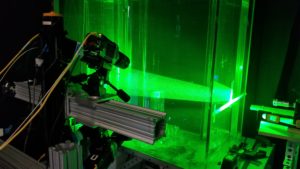In early 2016, the ASME Verification and Validation in Computational Nuclear System Thermal Fluids Behavior Committee (ASME V&V30 Standard Committee) has selected the high-fidelity experimental data obtained in the Twin Jets experimental facility as the first V&V benchmark problem.
The detailed announcement can be found on ASME’s official website https://www.asme.org/wwwasmeorg/media/ResourceFiles/Events/VandV/Model-Challenge-1-Announcement-Final-sans-Hyung.pdf
Scaled twin-jet experiments were conducted in our laboratory using the experimental facility. The State-of-art non-intrusive laser-based measuring techniques Laser Doppler Anemonetry (LDA) and Particle Image Velocimetry (PIV) were employed to measure the flow field with uncertainties quantified. The turbulent characteristics including the distributions of mean velocities, turbulence intensities, Reynolds stresses and z-component vorticity were also studied.

The experimental data not only is important for benchmarking steady-state RANS-based numerical simulations, but they also contributes with a unique set of data to the twin jets experimental database.
Experimental data and other general information on the experimental facility are available for download.

